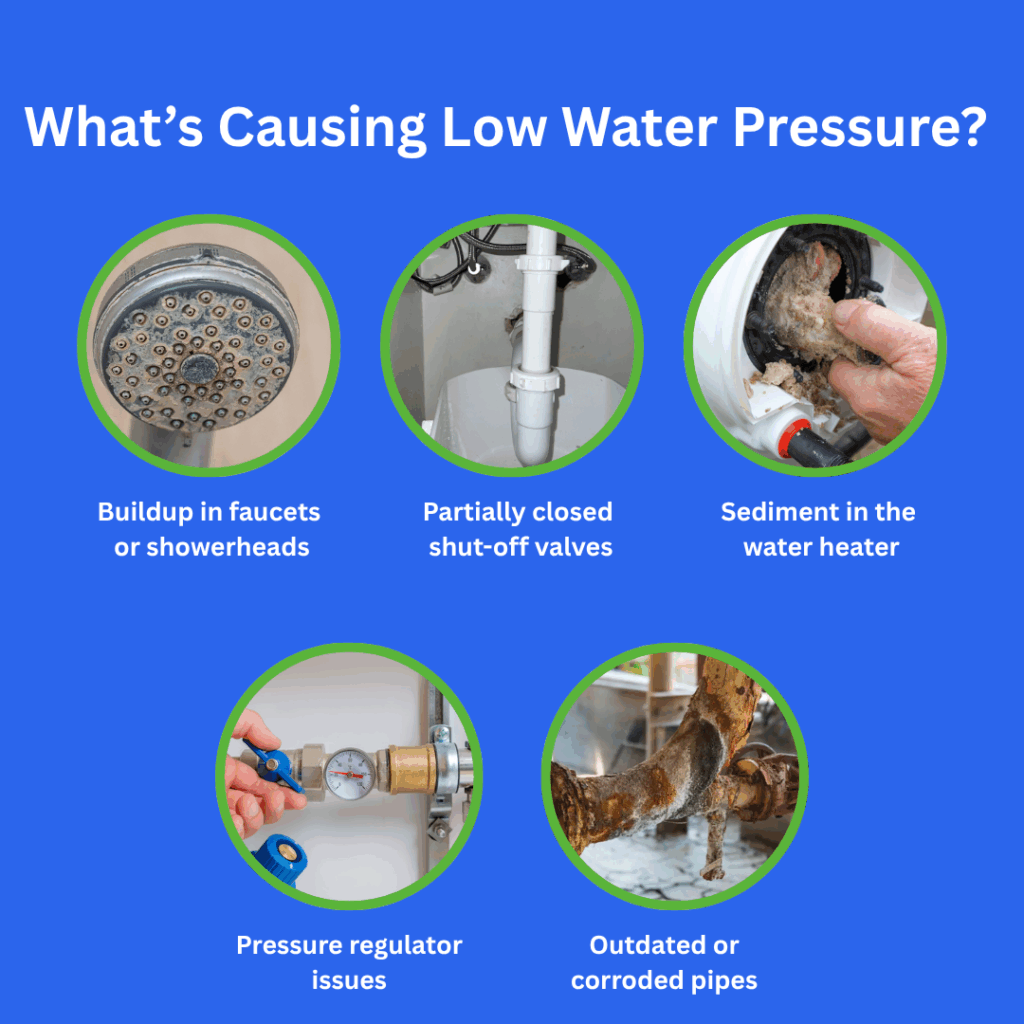“How do you increase water pressure in your house?” is a question many homeowners ask themselves.
Low water pressure can be a daily annoyance. Whether you’re waiting forever for the tub to fill or rinsing dishes under a slow stream, weak water flow gets in the way of everyday tasks.
If you’re wondering how do you increase water pressure in your house without spending a fortune, you’re not alone. The good news is that most water pressure issues have simple, affordable fixes. With a little know-how and a few smart moves, you can get your pressure back up without draining your wallet.
What’s Causing Your Low Water Pressure?
Before you increase water pressure in your house, it helps to know what’s behind it. Common causes of low water pressure include:
- Buildup in faucets or showerheads
- Partially closed shut-off valves
- Sediment in the water heater
- Pressure regulator issues
- Outdated or corroded pipes

Some of these are quick fixes. Others may need a plumber’s eye. According to the EPA, the average household loses about 10,000 gallons of water each year due to leaks and plumbing issues. That can impact not only your pressure but also your water bill.
Easy Fixes to Increase Water Pressure in House
1. Clean Your Faucet Aerators and Showerheads
Over time, mineral deposits from hard water can clog up your fixtures. This is one of the most common causes of poor pressure. The good news is it’s also one of the easiest to fix.
Here’s what to do:
- Unscrew the showerhead or aerator.
- Soak it in white vinegar overnight.
- Rinse and reattach.
This quick cleaning can make a big difference, and it costs next to nothing.
2. Check Your Main Shut-Off Valve
If you’ve recently had plumbing work done or moved into a new home, the main valve might not be fully open. Even a partial closure can cut down your flow.
Look for the valve near your water meter. Turn it counterclockwise to open it fully. No tools or cost involved — just a little twist.
3. Flush Your Water Heater
Sediment buildup inside your water heater can lower pressure in sinks and showers. It can also shorten the life of your heater.
You can flush it yourself by connecting a garden hose to the drain valve and letting the water run out. Just be sure to turn off the heater and water supply first.
Cost: Free if you DIY, or around $100 for a professional flush. Either way, it’s cheaper than replacing the whole unit.
4. Upgrade to a High-Efficiency Showerhead
Newer showerheads are designed to improve water flow without wasting water. Many have pressure-boosting technology built in.
Look for models labeled WaterSense, which use less water while improving performance. You can find quality options for $15 to $50 or higher. They’re easy to install and help reduce your water bill too.
5. Consider a Booster Pump (Only if Needed)
If your water pressure is low throughout the house and not due to a clog or valve issue, you may need a booster pump.
These pumps help push water through your system more forcefully. Entry-level models start around $200 to $300. This might seem like a big investment, but it can save you from costly plumbing problems down the road.
Before you buy one, talk to a plumbing pro to confirm it’s the right fix.
When to Call a Professional (and Save Money Doing It)
Sometimes, the issue goes deeper than what you can see. If you’ve tried the easy fixes and nothing works, a licensed plumber can:
- Test your home’s pressure levels
- Find hidden leaks
- Inspect pressure regulators
- Check for old or corroded pipes
Hiring a professional early can actually save money. You’ll avoid trial-and-error fixes or damage caused by unseen leaks.
At Enviroquest, we offer fair, up-front pricing for repairs. If we find the problem, you’ll know exactly what it’ll take to fix it with no surprises.
Quick Cost Guide & What to Expect
Most fixes for low water pressure are easier on the budget than you might think. Cleaning showerheads or faucet aerators usually costs nothing or just a few dollars if you need a vinegar soak or a replacement part. Checking and adjusting your main shut-off valve is completely free and takes only a few minutes.
Flushing your water heater is also low-cost. If you do it yourself, it won’t cost anything, but hiring a professional may run around $110 to $200. Swapping out an old showerhead for a high-efficiency model typically falls between $15 and $50, and you can install it yourself with just a wrench.
If you need a pressure booster pump, that’s more of an investment. Installation may be DIY-friendly if you’re handy, but some homeowners prefer to have a plumber handle it.
Finally, if none of these options solve the problem, a plumbing inspection is your best bet. A basic inspection might cost about $287 on average.
But many companies, like Enviroquest, offer free evaluations so you know exactly what you’re dealing with before any work begins.
Tips to Increase Water Pressure in House Over Time
- Clean fixtures every few months
- Schedule yearly plumbing inspections
- Avoid running washers, showers, and dishwashers at once
- Use water during non-peak hours (early morning or late evening)
- Upgrade outdated pipes if you live in an older home
Good maintenance now can prevent costly repairs later.
Wrap-Up: You Don’t Need to Spend Big for Better Pressure
Raising your home’s water pressure doesn’t have to mean spending a fortune. A few smart steps and simple fixes can make a big difference in comfort, water savings, and long-term performance.
If you’ve tried the basics and pressure is still low, it might be time to bring in a professional. At Enviroquest, we’re here to help, whether it’s a simple check or a full system solution.
Wondering what’s really behind your low water pressure? Contact us today for a pressure evaluation and practical advice that fits your home and your budget.
